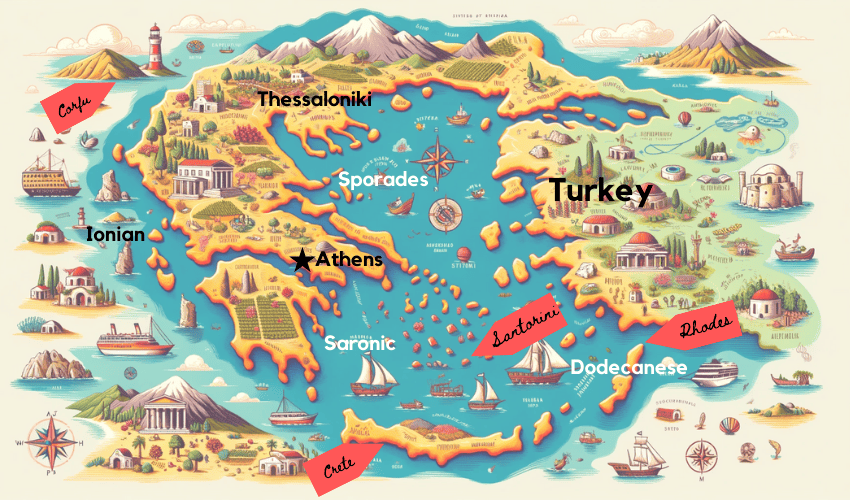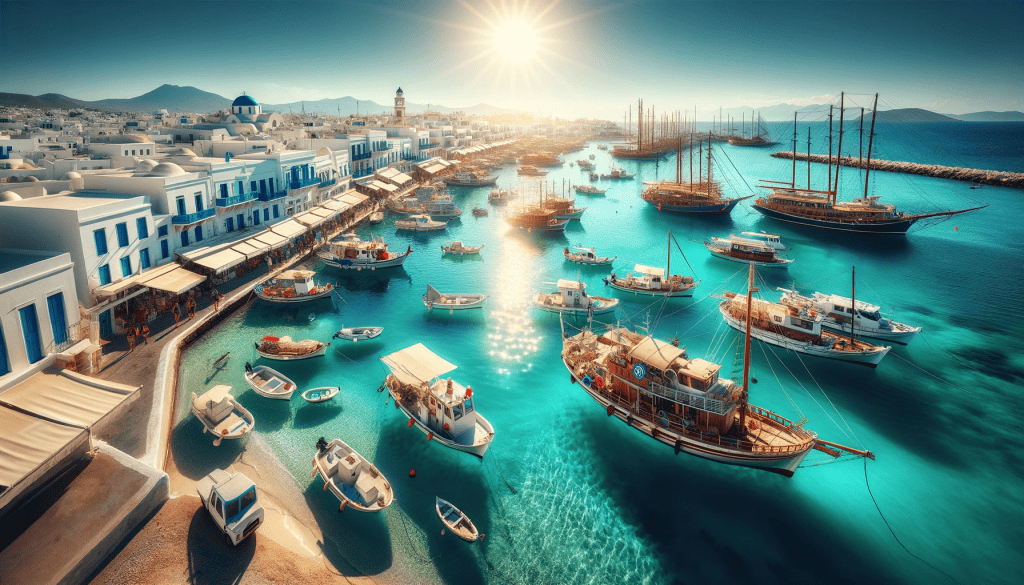A short guide to explore the Greek islands adventurously
If you’re looking for an adventure that combines breathtaking scenery, rich culture, and delicious cuisine, then Greek island hopping should be on your bucket list. Greece is a country with over 6,000 islands and islets (of which 227 are inhabited), each with its own unique charm and beauty. Island hopping allows you to explore multiple destinations in one trip, creating a diverse and exciting experience. In this article, we will guide you through the basics of Greek Island Hopping, including how to plan your trip, the most popular islands to visit, transportation options, a map of Greece and the Greek Islands to help you plan your itinerary, and tips for making the most of your island hopping adventure.
What is Greek island hopping and how to plan your trip
Greek island hopping is a popular way to explore the Greek islands and experience their unique culture, history, and natural beauty. It involves traveling from one island to another, usually by ferry or catamaran, spending a few days on each island before moving on to the next one. Planning your Greek island hopping adventure can seem daunting at first, but with a little research and preparation, it can be an unforgettable experience.
Start by deciding which islands you want to visit and how long you want to stay on each one. Consider factors such as:
- Transportation options;
- Accommodation availability;
- The activities and attractions you want to see.
It’s also important to plan your trip during the right season, as some islands may be less accessible or enjoyable during the off-season. Once you have a rough itinerary in mind, book your transportation and accommodation in advance to avoid any last-minute stress. With careful planning, Greek island hopping can be an incredible adventure that you’ll never forget.
The Greek islands clusters
- Cyclades: This is probably the most famous group, located in the central part of the Aegean Sea. The Cyclades are known for their iconic white and blue houses and windmills. Santorini and Mykonos are part of this group. Lesser known Cycladic islands are Amorgós and Donoussa.
- Dodecanese: Located in the southeastern Aegean Sea, close to the coast of Turkey. This group includes islands such as Rhodes and Kos.
- Ionian Islands: Found off the west coast of mainland Greece in the Ionian Sea. The seven main islands are Corfu, Paxi, Lefkada, Ithaki, Kefalonia, Zakynthos, and Kythira.
- Sporades: Located off the east coast of mainland Greece in the northwest Aegean Sea and include Skiathos, Skopelos, Alonissos, and Skyros.
- Northeastern Aegean Islands: Situated in the Aegean Sea close to the Turkish mainland and include Lesvos, Chios, Samos, and Lemnos among others.
- Saronic Islands: Close to Athens, they include Aegina, Poros, Hydra, Spetses, and a few smaller ones.
- Crete: The largest island in Greece, located at the southern edge of the Aegean Sea. It is often considered its own entity due to its size and distinct culture and history.
Popular Greek islands to visit during island hopping
Greece has 227 inhabited islands, and each one has its own unique charm and attractions. However, some islands are more popular than others for island hopping adventures, such as:
- Santorini is a top destination, known for its stunning sunsets, whitewashed buildings, and volcanic beaches.
- Mykonos is another popular island, famous for its vibrant nightlife, picturesque windmills, and golden sand beaches.
- Crete is the largest Greek island and offers a diverse range of activities, from exploring ancient ruins to hiking in the mountains.
- Rhodes is known for its medieval old town and beautiful beaches.
- Corfu offers a mix of history, culture, and natural beauty.
- Other popular islands include Naxos, Paros, Ios, and Zakynthos.
When planning your island hopping adventure, consider visiting a mix of popular and lesser-known islands to get the most out of your trip.
How to get around the Greek islands during your island hopping adventure
Getting around the Greek islands during your island hopping adventure can be both exciting and challenging. The most common mode of transportation between islands is by ferry or catamaran, with various companies offering different routes and schedules. It’s important to research the ferry schedules in advance and book your tickets early, especially during peak season when they can sell out quickly. Once on the islands, there are several ways to get around, including buses, taxis, rental cars, and scooters. Buses are usually the most affordable option and connect major towns and villages on each island. Taxis can be more expensive but offer convenience and flexibility. Rental cars and scooters are a great way to explore the islands at your own pace, but be aware that roads can be narrow and winding in some areas. Always wear a helmet when riding a scooter and drive safely. With careful planning and a sense of adventure, getting around the Greek islands can be an enjoyable part of your island hopping experience.
A map of Greece and the Greek islands to help you plan your itinerary
A map of Greece and the Greek islands is an essential tool for planning your island hopping itinerary. The country is divided into several regions, with the islands scattered throughout the Aegean and Ionian Seas, as listed above. It’s important to consider factors such as distance and travel time when planning your itinerary, as some islands may be further apart than others.
Average length from an island to another
- From Athens to Santorini, a ferry trip takes on average 5 hours.
- From Athens to Mikonos, a ferry trip takes on average 3 hours.
- From Athens to Crete, a ferry trip takes on average 8h30 hours.
- From Athens to Corfu, a car & ferry trip takes at least 7 hours.
- From Athens to Rhodes, a ferry trip takes on average 13 hours.
- From Athens to Hydra, a ferry trip takes 2 hours.
- From one Cycladic island to another, a trip can take from less than 30 minutes to 2 or 3 hours.
Tips for a successful and enjoyable Greek island hopping experience
Greek Island Hopping can be a thrilling adventure, but it’s important to plan ahead and keep a few tips in mind to ensure a successful and enjoyable trip:
- Pack light and bring comfortable shoes, as you’ll likely be walking around a lot.
- Be flexible with your itinerary and don’t try to see too much in too little time.
- Take breaks when needed and enjoy the slower pace of island life.
- First check the ferries’ routes to plan your own route.
- Try the local cuisine and drinks, as each island has its own specialties.
- Respect the local culture and customs, such as dressing modestly when visiting religious sites. Fifthly, be mindful of the environment and dispose of waste properly.
- Don’t forget to take plenty of photos and create lasting memories of your island hopping adventure.
With these tips in mind, you’re sure to have an unforgettable experience exploring the beauty and charm of Greece’s many islands.
Conclusion
In conclusion, Greek Island Hopping is an adventure that should be on everyone’s travel bucket list. With over 6,000 islands to choose from, each with its own unique character and attractions, there’s something for everyone. By planning ahead, choosing the right islands, and following a few simple tips, you can create a memorable and enjoyable island hopping experience. Whether you’re looking to relax on sandy beaches, explore ancient ruins, or indulge in delicious food and wine, Greece has it all. Don’t forget to bring a map of Greece and the Greek islands to help plan your itinerary, and be prepared to be amazed by the stunning scenery and warm hospitality of the Greek people. So pack your bags, put on your sunscreen, and get ready for the adventure of a lifetime!



